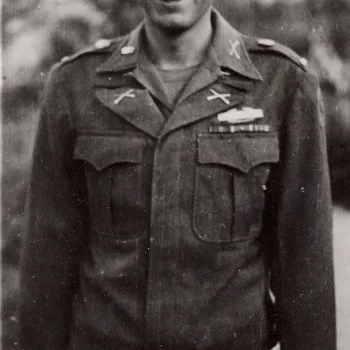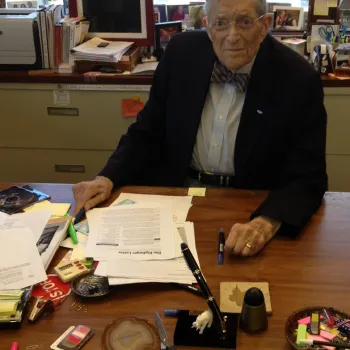I was appointed for life and I’m going to serve out my term. … it’s a performance of a duty, the same as I was doing when I was in Europe. I’m very big on duty. —Judge Stagg
In this audio interview, U.S. District Judge Tom Stagg of the Western District of Louisiana recounts his World War II combat experience and subsequent judicial career. Judge Stagg, who sits in Shreveport, La., served in the U.S. Army from 1943-1946, retiring as an infantry captain.
WWII Highlights:
- Landed in Marseille, France, in October 1944.
- Engaged in combat in the Lower Vosges Mountains in France and along the Siegfried Line in Germany.
- Received two Bronze Stars, two Purple Hearts, and a Combat Infantry Badge.
Transcript
Q. Tell me how you got into the Army.
A. As a youngster, I was ambitious to go to West Point … but if your math grades really are problems, youneed to cure those before you place yourself in the entrance exam. ... So I went off to a military school after high school, in Marion, Alabama, called the Marion Military Institute. And while I was there “in summer camp”, and I was between the third and fourth year of ROTC, I got a call from my Dad telling me I got a telegram ordering me to report to West Point. Apparently, the principal appointee failed the physical. … I said, “Hell, Pop, what shall I do?” He was convinced that Roosevelt was going to get us into the war. … He says, “You go to West Point and you’ll be a second lieutenant in four years. If you go to LSU, you’ll be a second lieutenant in nine months. … I had ROTC in high school, I had ROTC in college. That got me commissioned in May of ‘42, and I went on duty in January of ‘43 at the ripe old age of 20 years. Nobody in my outfit was that young, and I wouldn’t tell anybody how old I was because I was the youngest one, and I was their boss.
Q. What were your duties in Europe?
A. The war later put me into the 103rd Infantry Division, and in October 1944, we went overseas and landed in Marseilles, and our division followed the three invading divisions … and we plowed in behind them, and the first conflict we were in was in the Low Vosges Mountains in Alsace.
I was an infantry officer, I was the weapons platoon leader in a rifle country. … In that part of Alsace, it was very hilly. It was like mountain warfare on small mountains, and we would move at night, and find a hole in the German defenses, or make one, and go behind them and dig in, and they would have to move. And then we’d move again, and it was that kind of off-beat warfare.
Q. Was any event in Europe most memorable to you?
A. (Immediately after returning from a brief hospital stay …) The battalion commander wanted E Company, my company, back at the battalion CP. And here we are in the middle of the Low Vosge Mountains, in the middle of the night, E Company’s runner was there. … So the runner and I set out in the dark, stopped in a Frenchman’s house at the edge of town to make sure we were on the road or pathway (to E Company). He said, "Yes, but wait, I’ll show you." On our way, we stopped at his brother-in-law’s house to inquire of Germans in the immediate area .… We get to this opening and there were three two-story farmhouses. One of them had lights on, so I sent the Frenchman up to make inquiry. I didn’t hear anyone challenge us, as you’re supposed to be if that’s where E Company is. … When the door opened, it was a German with a machine gun, the fastest damned machine gun I ever heard. And that mowed the Frenchman down, and it got me in the left shirt pocket, where my Bible was. And the bullet went through the Bible, and it went through me. It knocked me to the ground. It was about like a half swing with a baseball bat. And I wriggled away, he couldn’t see me, but my helmet rolled down the hill, and he (kept) shooting at my rolling helmet. …
I went into a little chicken coop place and hid for a while, and nobody came out, and I went back to the brother-in-law’s house, bleeding, making a mess on the floor. And that small Frenchman took me into the side of the house where the barn was and took me up a ladder to the hay loft. In the early morning, the Frenchman came up the ladder and said I had to leave—it was barely daylight—because if the Germans found me in his house, they would shoot them all. So I left, and when I got to the battalion CP, it was full daylight by then. … I said,” I need a medic, help me.” Well, that far up in advance there were no ambulances, so they strapped me into a jeep, literally tied me to a front seat sitting up, and took me to the field hospital.
Q. Where were you in the final stages of the war?
A. On March 15, there was a large move forward, two Armies, Patton and ours, the Seventh and the Third, started an offensive through the Maginot Line, then through the German line and on into Germany. We spent Easter on the banks of the Rhine River. On V.E. Day we were in Austria. …
I was the company commander by then. I’d been promoted to captain, and I had a Bronze Star for Valor, and two Purple Hearts, and a Bronze Star for Meritorious Service. I was well satisfied with the collection. After V.E. Day, I was transferred to the Sixth Corps Headquarters. They were wearing formal uniforms and neckties, and I was in my wrinkled field clothes. When you go in fully dressed and you had a Combat Infantry Badge, and Bronze Stars and Purple Hearts, they looked at that with some awe. And I don’t blame them because they never heard a bullet go off.
Q. Do you still wear a Combat Infantry Badge today?
A. I do. It’s a miniature of a Combat Infantry Badge. It is a singular military award. If you were not shooting and being shot at, you can’t wear the Combat Infantry Badge. That badge tells anybody that sees it that this is a combat soldier, not a cook or a messenger, you’re a fighting soldier. It’s on every lapel of every suit I own.
Q. Tell me how you became a federal judge.
A. In those days, Louisiana was (Huey) Long and anti-Long. I set out to make Louisiana a two-party state, and we managed that over the years. I knew President Nixon, and he knew me, and when Judge Dawkins retired, I got the job. I never planned to be a federal judge. I was making plenty of money, practiced law for 25 years, I’ve been a federal judge for 40 years, and I’m in my 92nd year, and I’m right here at work at my desk, where I belong.
Q. What makes you continue to serve on the bench?
A. I was appointed for life and I’m going to serve out my term. … it’s a performance of a duty, the same as I was doing when I was in Europe. I’m very big on duty, I was given a duty by President Nixon, and I have done my damnedest to carry it out for the 40 years I’ve been here.
Q. What qualities do you consider most important as a judge?
A. When a Senate committee hears from a person who’s been nominated, the first area they ought to cover is his judicial temperament. Does he bite at people, does he pound on the bench, does he go over the edge in criticizing people? … If you treat every lawyer with respect, even if he loses, he’s not going to have a great deal of disaffection. He was treated fairly. That’s the object of T. Stagg as a judge, is that you’re going to get treated fairly.
Q. Do you consider yourself to be part of a “Greatest Generation”?
A. Compared to what I see today, yes. I think you get duty pounded into you, or did in those days, and you learn it as boy, as a Boy Scout, as a member of a military unit. You have assigned duty and you have to do it. You even want to do it. I would no more have stayed home during World War II. I can’t imagine doing that. This is my country. I’m proud of it.
Subscribe to News Updates
Subscribe to be notified when the news section is updated.


